A minimum viable product (MVP) is a cost-effective way to confirm whether your business idea truly addresses the problem you believe it does. And yet, many startups fail to develop an MVP and go straight into full product development. The result? Only 1 out of every 5 new businesses survive.
With around ten years of experience as a full-cycle software development company, Syndicode has honed its expertise in developing MVP products. We assist our clients in shaping their product concepts and bringing them to life within the shortest time. Check out our featured projects to see our expertise in your industry.
This blog post will explore the essentials of creating a successful MVP, including common challenges. You will also see examples of well-known businesses that started as MVPs and get a framework for estimating the cost of an MVP development project.
We’ll start with the basics, but you can skip right to the steps by clicking here.
What is an MVP?
An MVP or a Minimum Viable Product is a simplified version of a product, containing just enough features for early users to try and give feedback on. This helps avoid spending too much time on an idea that doesn’t gain traction.
In other words, an MVP is an experiment in the business world to test if a new idea is viable and profitable. MVPs can be used to see if there is a market need for a product or to improve an existing solution.
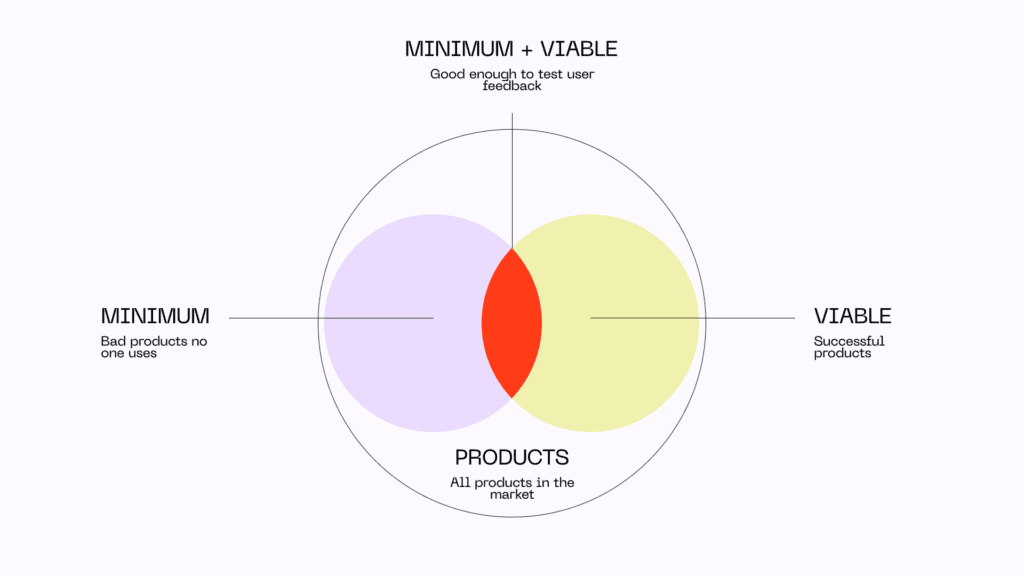
Why build an MVP?
The main advantage of MVP development is that it helps you determine if your product fits the market. It acts as a safety net, saving you from investing in a product nobody wants.
Here’s how it works:
- Refining your idea: An MVP lets you test your product with customers. You can see how they react, what they like, and what you might have missed.
- Attracting clients and investors: An MVP is a great way to showcase your idea and secure funding.
- Boosting development efficiency: Feedback from the MVP helps you focus on the right things and use your resources wisely.
Reducing time to market: An MVP can be a helpful solution on its own or help you improve your full-scale product faster and position it for maximum profit.
Which technology is ideal for creating an MVP?
Ruby on Rails is known for its rapid development and exceptional performance. It is an ideal choice for MVPs, even if you plan to use a different tech stack for the full product.
Learn more9 benefits of an MVP
- Market validation: An MVP allows you to test your product in the real market with real users, providing valuable feedback and data on user preferences and behaviors.
- Iterative development: Starting with an MVP lets you take an iterative approach to development. You can release basic features, gather feedback, and then gradually add more features based on user input. This agile approach often leads to a more user-centric and successful product.
- Focus on core value: Building an MVP forces you to identify and prioritize the core value proposition of your product. This focus on the essentials leads to a more streamlined and user-friendly product.
- Risk mitigation: By starting with a smaller investment (in time, money, and resources), you reduce the risk of building a complete product that might not gain traction in the market. If your MVP doesn’t perform well, you can pivot or refine your idea without significant losses.
- Early user acquisition: With an MVP, you can build your user base and generate interest in your product before it’s fully developed. This can be crucial for creating a buzz, attracting early adopters, and building a community around your product. Having a user base to engage with can also reduce marketing costs over the long term.
- Competitive advantage: Getting your product to market faster with an MVP allows you to capture market share before competitors catch up.
- Resource allocation: Building an MVP helps you prioritize development efforts based on user feedback and market demand, allocating resources more efficiently.
- Learning experience: Developing an MVP is a valuable learning experience for your team. It allows them to gain insights into product app development, user research, and the startup ecosystem, which can be applied to future projects.
- Investor confidence: Investors often prefer startups that have validated their ideas with an MVP. Demonstrating that you’ve tested your concept and have actual user data can significantly increase investor confidence.
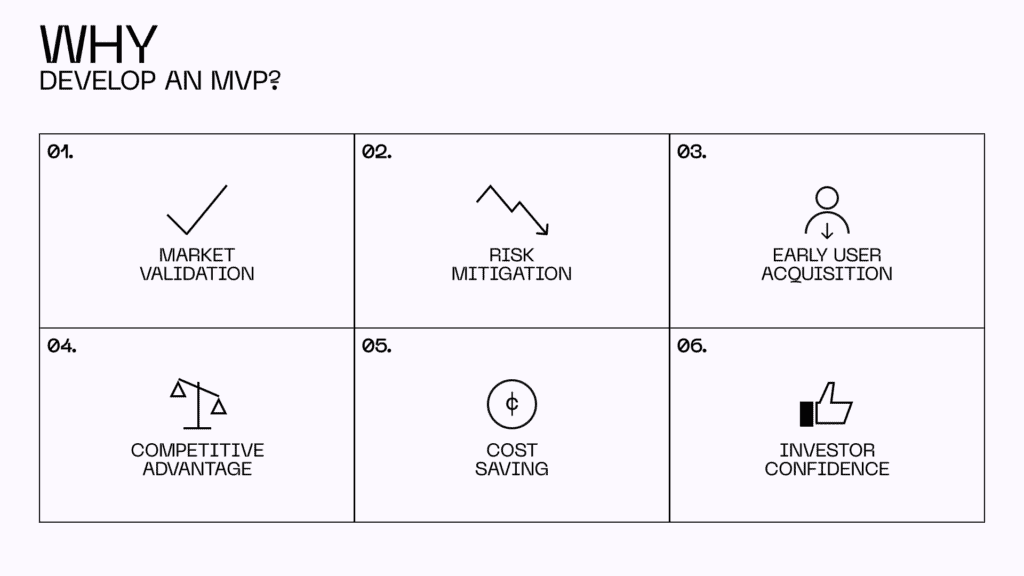
How to build a successful MVP?
Before finding out how to design an MVP, ensure you have a clear idea of what you’re trying to create.
MVP planning starts with answering these questions:
- What problem will my project solve?
- How will it be helpful for the end user?
- Why would they want to use my MVP solution?
Furthermore, you might want to start interacting with investors. You likely won’t get any funding before you actually build something, but it never hurts to develop some contacts. When the development is fully underway, you will only have limited time to spend on investor search.
Step 1. Research the market
Market research is crucial at the MVP stage for several reasons:
- Understanding customer needs
- Identifying gaps or opportunities
- Determining the size and growth of the potential audience
- Understanding competition
Market research provides insights that inform product development, marketing strategies, and overall business decisions. With a solid understanding of the market, you can avoid making costly mistakes and missing out on valuable opportunities.
Here’s a step-by-step guide on how to conduct market research to build an MVP:
- Define your objectives: What specific information are you seeking to gather, and what decisions will this research influence?
- Identify your target audience: Who are your potential customers? What are their demographics, interests, and behaviors?
- Research online resources: Industry reports, market research studies, and articles can provide data about market trends, growth projections, and customer behavior. Social media platforms, forums, and online communities related to your industry or niche are another excellent source of insights into customer sentiment.
- Use keyword research tools to identify relevant search terms and phrases related to your product. This can help you understand what potential customers are searching for online.
- Analyze competitors: Look at their products, strengths, weaknesses, and market positioning. SWOT analysis is a popular method for understanding the competitive landscape.
- Survey and interview customers: Gather insights into their needs, pain points, and preferences.
- Use focus groups: Present your MVP idea to diverse individuals and gather feedback. This can provide valuable qualitative insights.
- Document your research findings and insights, and then organize and analyze your gathered data. Look for patterns, trends, and critical insights that will help shape your MVP development strategy.
- Iterate and refine: Use your findings to refine your MVP concept and strategy and repeat the process regularly to gather more information and keep up with the market dynamics.
Upon completing these steps (and before moving further), you should have a good idea about your target market’s size, geographical distribution, and willingness to pay for a solution like yours.
Moreover, you should know the pricing models of similar products in your market and industry-specific or legal requirements that may impact the life of your MVP.
Need help with your MVP research?
Our business analysts will prepare a detailed report on your target market and opportunities.
Send messageStep 2. Define MVP scope
Focus on delivering the core value of your product with the fewest features possible. Here’s how to build an MVP with only the essential features:
1. Define the MVP’s core objective: What problem does it solve, and what is the core value it delivers to users? This will serve as your guiding principle throughout feature selection.
2. Create a list of all possible features: Brainstorm all the functionalities you envision for your product. This list should be exhaustive, including everything you believe could be valuable.
3. Consider user needs and feedback: Prioritize features directly addressing your target audience’s pain points.
4. Evaluate competitor products: Identify features that are considered the industry standards and those that differentiate your product. Focus on the latter.
5. Define a minimum feature set: These are the features that are required to deliver your MVP’s core value proposition. Without them, the product won’t make any sense to users.
6. Access technical feasibility: Consider the development effort required for each feature. Prioritize features that can be implemented within your time and resource constraints.
7. Use prioritization frameworks to evaluate each feature’s importance. Some common frameworks include:
- MoSCoW Method: Categorize features as Must-Have, Should-Have, Could-Have, and Won’t-Have.
- Kano Model: Classify features into Must-Be Quality (expected features), Performance Quality (linear impact on satisfaction), and Excitement Quality (delighters).
- Value vs. Effort Matrix: Plot features on a matrix, considering their potential value and the effort required to implement them.
8. Validate your prioritization: Seek input from stakeholders, team members, and potential users. Their perspectives can help ensure you haven’t overlooked critical elements.
9. Develop a feature roadmap: Outline the MVP features and those for future iterations. This ensures that you have a clear vision beyond the initial release.
Once you have a clear scope, you can start making initial time and cost estimates for the MVP product development. Consider the complexity of the features, the size and expertise of your development team, and any potential third-party services or tools you’ll need.
Additionally, be prepared to revisit and adjust your feature priorities as you gather more feedback, data, and insights during MVP app development.
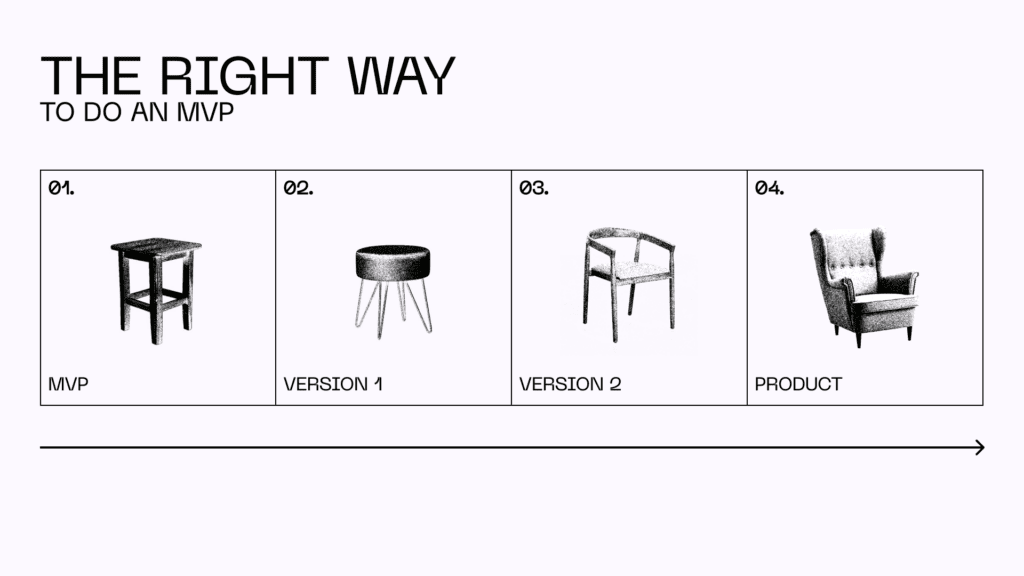
How to prevent scope creep?
Since MVP implementation is more like an art than science, your development plan will likely evolve. This evolution can cause the initial project scope to expand, affecting both the timeline and the budget. Here are some steps to avoid scope creep:
- Freeze scope after a certain point: Establish a point in the project timeline beyond which scope changes are discouraged or will require significant justification. This encourages stakeholders to address their needs and concerns early.
- Avoid gold-plating: Gold-plating refers to adding features or enhancements beyond what is essential to meet project goals. Discourage team members from over-engineering or adding unnecessary elements.
- Follow the Agile approach: Use techniques like user stories, sprint planning, and retrospectives to maintain flexibility while still controlling scope.
Step 3. Determine business model
While an MVP’s primary goal isn’t revenue generation, it’s essential to determine a viable revenue model for the full-fledged product. Besides, with the MVP, you can test several revenue streams and make an informed choice as you transition to a more mature product. Consider the following steps:
1. Use market research to understand potential revenue opportunities, pricing models, and competitive benchmarks.
2. Leverage user feedback: Consider what users are willing to pay for and how they perceive value.
3. Explore business models: Choose those that align with your product and target audience. Typical revenue streams include:
- Subscription: Charging customers a regular fee to access your product or services.
- Transaction Fees: Taking a percentage or fixed fee for each transaction conducted through your platform.
- Advertising: Selling ad space or displaying ads to users.
- Freemium: Offering a free basic version with premium paid features.
- Licensing: Licensing your technology or intellectual property to other businesses.
- E-commerce: Selling physical or digital products directly to consumers.
- Affiliate Marketing: Earning commissions for referring customers to other businesses.
4. Pilot and test: Before fully implementing your chosen revenue model, consider piloting it with a subset of users or in specific markets to assess its viability.
5. Iterate and optimize: Adjust your revenue model as you get more market insights and customer feedback.
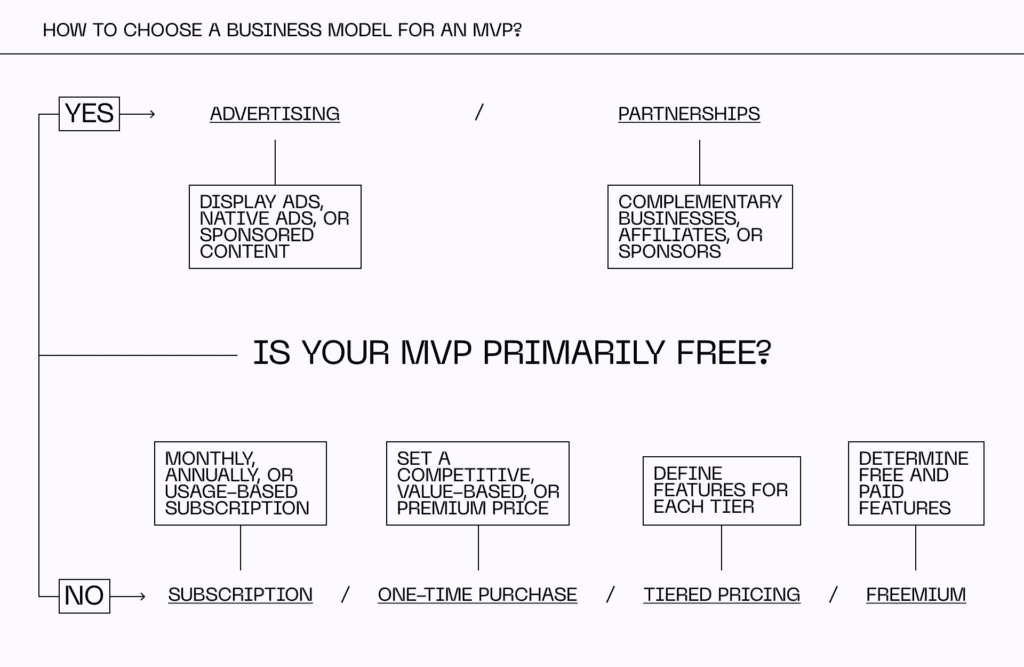
Step 4. Wireframing and prototyping
Wireframes, mockups, and prototypes help visualize your product’s user interface and functionality before investing in full development. They also help prevent costly design changes later in the development process.
Here’s a step-by-step guide to visualizing your MVP:
1. Ensure clear objectives, scope, and requirements. You must clearly understand what the user should be able to do with your product and what it should look like. The list of core features, user stories, and use cases will guide your efforts.
2. Choose tools that suit your needs. Popular options include:
- Balsamiq: A user-friendly wireframing tool.
- Sketch: A vector-based design tool.
- Figma: A collaborative design and prototyping tool.
- Adobe XD: A design and prototyping tool by Adobe.
- InVision: A prototyping and collaboration platform.
- Axure RP: A more advanced prototyping tool for complex interactions.
3. Start with wireframes. Wireframes are simple, low-fidelity representations of your product’s interface. Create wireframes for each screen or page in your MVP. Focus on layout, content placement, and basic interactions. Use placeholders for images and text to avoid getting caught up in design details at this stage.
4. Define user flows. Map out the user journey through your MVP and identify the key paths users will take to accomplish their goals. Connect wireframes to show how users navigate from one screen to another.
5. Get feedback and refine. Share your wireframes with team members, stakeholders, and potential users to gather feedback on usability, flow, and functionality.
6. Create high-fidelity mockups. Once your wireframes are solid, you can introduce more design elements, fonts, colors, and branding. Mockups give stakeholders a better sense of what the final product will look like.
7. Create interactive prototypes and test them. Use your chosen prototyping tool to link screens together to simulate user interactions. Define how buttons, menus, and other elements behave when clicked or tapped. Show the prototypes to real users or team members to identify usability issues or bugs.
8. Document your wireframes, mockups, and prototype interactions to assist developers as they build the MVP.
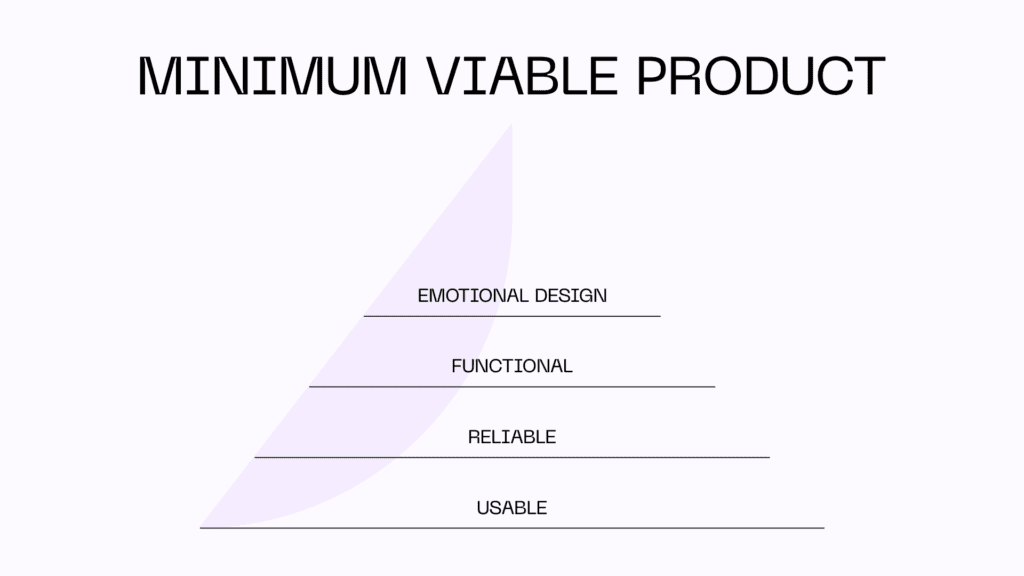
Step 5. Decide on the tech stack
Choosing the right tech stack for your MVP is crucial as it can significantly impact your project’s success. Here’s a step-by-step guide to help you select a suitable tech stack:
- Consider your team’s expertise. It’s often more efficient to work with technologies your team is familiar with, as this can reduce the learning curve and development time.
- Evaluate project needs. Use the list of crucial features made earlier and talk to software engineers to understand the technical demands of your project. Think also about the long-term scalability requirements of your project to avoid major rewrites.
- Consider creating a Proof of Concept (PoC) to test the feasibility and compatibility of your chosen tech stack with your project’s requirements.
In the table below, you can see the top popular tech stacks used to build an MVP. With your chosen tech stack in mind, revisit and refine your time and cost estimates.
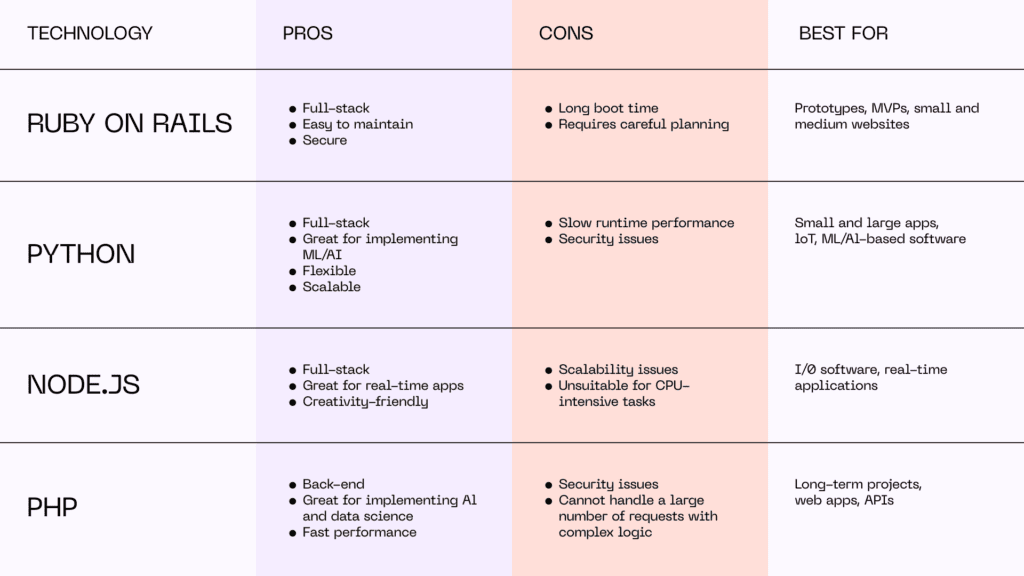
Step 6. Develop a Minimum Viable Product
Now that you have the essential ingredients sorted out — the target market, the features, and mockups — you can start creating a software product. First, you should decide on the hands to create an MVP.
You have three ways to go about this:
- Hire your own talent to build an MVP
This option gives you complete control over your team’s composition and the way they work. Also, communication is faster, which is good for quick fixes and change handling.
However, in-house development takes more time and money since you must find and hand-pick professionals, set up the IT infrastructure, provide office space, pay overheads, etc. Therefore, it isn’t well-suited for a first-time project.
In addition, you must know how to build an MVP from the technical side to manage development tasks properly. On the other hand, you can get on-demand IT consulting services to help you out.
- Outstaffing
This engagement model involves hiring temporary employees from an external vendor. Sometimes, it goes under the “dedicated team” name. The outstaffed specialists work under your management, allowing you to arbitrate costs by being fully remote.
Furthermore, a dedicated development team gives you access to a broader talent base. You also become more flexible in scaling your team or replacing an employee.
Yet, be careful when selecting an outstaffing vendor to avoid miscommunication and motivation problems within the team. Besides, this model requires your full attention for the project’s outcomes.
- Outsourcing
Outsourcing is the practice of farming out the development to a third party. Similarly to outstaffing, this is a remote model where you may choose to outsource within your country, nearshore, or offshore.
The benefits of outsourcing include lower costs, access to a wide assortment of skills and innovations, and increased flexibility. You can better focus on strategy or your core competencies since the management usually occurs on the vendor’s side. As a result, outsourcing becomes a preferable option for startups and first-time entrepreneurs.
Besides, with the outsourcing model, you don’t have to be directly involved in developing the MVP, freeing your time for business-related tasks.
| Model | In-house | Outstaffing | Outsourcing |
|---|---|---|---|
| Pros | Full control over the project Enhanced security | Flexibility in team size Reduced cost Rapid response to project changes | Reduced cost Specialized skills/knowledge Turnkey delivery |
| Cons | Time and cost investment Possible skill gaps Risk of limited vision | Culturally diverse team Possible performance issues | Language/cultural barriers Possible lack of control |
| Best for | Long-term development and security-sensitive projects | Large or continuous projects | Small and one-time projects |
Step 7. Testing and QA
The importance of quality assurance and testing in minimum viable product development is hard to overestimate. It ensures the MVP meets its intended objectives and delivers a quality user experience. The steps for effective planning and execution of MVP testing are:
- Identify goals and success criteria for testing.
- Develop a testing strategy outlining the types of testing you will perform, such as functional, usability, performance, security, and more.
- Develop test plans that specify what will be tested, how it will be tested, and what success criteria or acceptance criteria should be met.
- Create test cases for each aspect of your MVP, including positive and negative scenarios. Test cases should cover all critical features and functionalities.
- Decide on using automated testing, manual testing, or a combination of both. Automated testing is efficient for repetitive tasks, while manual testing provides a human perspective on usability and functionality.
- Execute different testing types to ensure the proper performance of the MVP under various conditions and assess its usability, security, and compatibility with other platforms and devices (if applicable). Iterate for changes and improvements.
- Document results for future reference, including any defects, issues, or areas that require improvement.
- Perform post-deployment monitoring for performance, security, and user experience. Address any issues promptly.
Software testing and QA can be time-consuming, sometimes taking as long as the development phase. However, this shouldn’t be a reason to skip or rush through. You can still use your MVP to collect early user feedback before completing all the testing tasks. Here are key points in your project timeline where you can share your MVP with a small group of users or your internal team to gather feedback:
Collect early user feedback during MVP testing and QA
- Alpha testing can be performed as soon as you have a working but not fully polished MVP version. It can help find major issues and assess core functionality.
- Closed beta testing phase can be done after addressing significant issues identified during alpha testing. Invite a limited number of users who match your target audience to use the MVP and collect feedback on usability, functionality, and overall satisfaction.
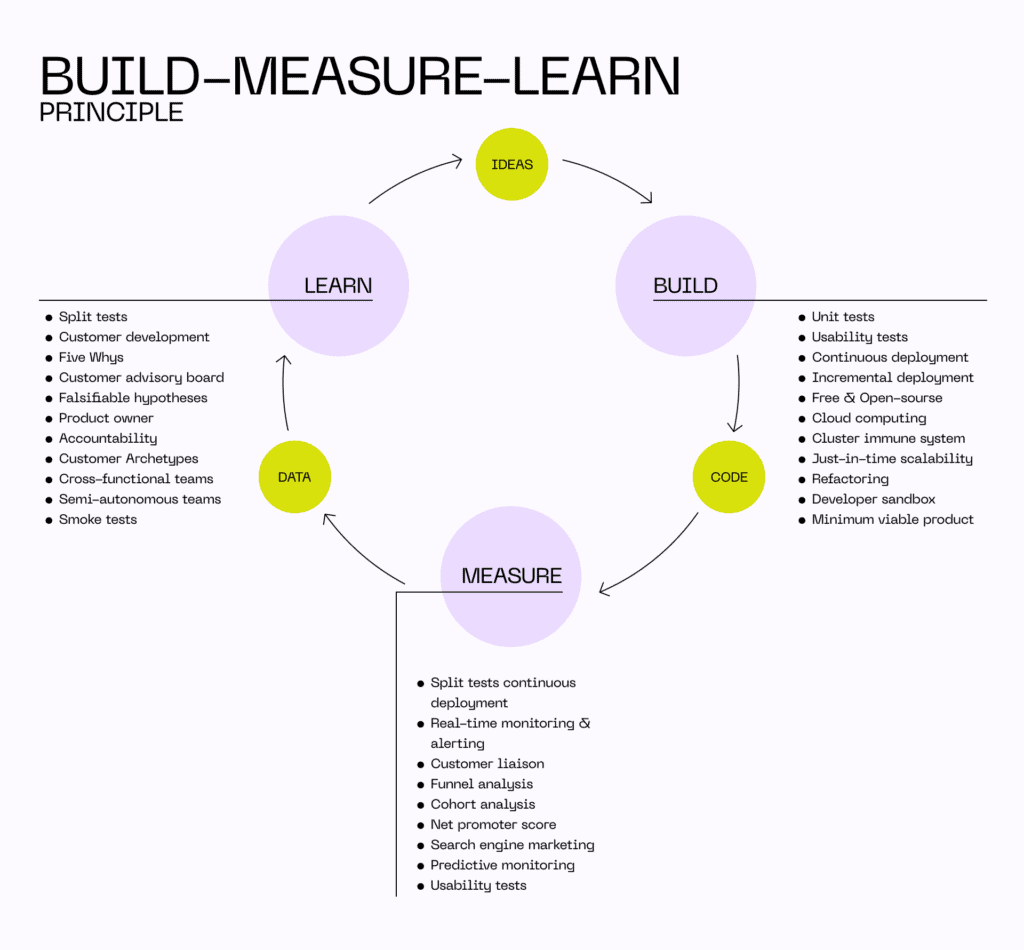
Step 8. Launch, monitor, improve
Deploying and launching an MVP involves several key steps, including monitoring and error tracking, collecting user feedback, and prioritizing feature requests and bug fixes.
The general steps are:
- Deploy your MVP to make it accessible on a server or hosting environment. It involves getting your MVP and its components ready to run in a production environment.
- Monitor and track errors.
- Plan and perform launch activities. This should involve marketing, promotion, and user acquisition strategies and preparing your customer support team to assist users and address inquiries.
- Collect and act on user feedback, making incremental improvements to your MVP.
As you’re ready to place your MVP on the market for the first customers to try, you may take one of the several approaches:
- Soft launch. It is a product release to a limited number of users to reduce financial risks, identify bugs, and test the monetization strategy;
- Hard launch. It is a release with massive marketing activities to attract a broad audience. Few MVPs go hard launch unless there is a predictable audience;
- Dark launch means releasing a product in versions and introducing each new feature to a few users to test. This approach is based on continuous delivery.
Step 9. Prepare to scale
Once you’ve got a solid user base and a good understanding of their needs, it’s time to prepare for scaling your product and transitioning from an MVP to a complete solution.
The following steps will help you ensure that your future product can handle increased user demand as it gains popularity.
- Define the full product vision and prioritize feature development based on user feedback and market analysis. Next, create a product roadmap outlining the feature development and release timeline.
- Ensure your team is ready for scaling in terms of having the necessary resources and expertise. Depending on the scope of the full product, you may need to expand your development team.
- Review your MVP’s architecture to ensure it can support the new features and increased complexity of the complete product.
- Adopt an iterative development approach where you release new versions or updates of the product at regular intervals.
- Intensify testing efforts to ensure the reliability and quality of the expanded product.
- Launch the expanded product to the public and closely monitor its performance and user reception.
- If your MVP didn’t have a clear revenue model, finalize and implement your monetization strategy for the full product.
Your perfect team is right here
List your requirements, and we will return to you with fitting candidates’s CVs. Start building the team that will turn your MVP into a world-famous product!
Write usHow to measure MVP success?
To measure the success of your MVP, you should be able to evaluate its attractiveness to a viable pool of customers and its value in solving the target user’s problem. The metrics that can help answer both questions are as follows.
- Increasing KPIs, such as user engagement, conversion and retention rates, qualitative user feedback, customer lifetime value (CLV), and revenue (if applicable).
- User growth is another metric that indicates interest and adoption.
- Industry benchmarks: If available, compare your MVP’s performance against industry benchmarks to gauge your faring relative to similar products or services.
Pivoting a failing MVP product
Sometimes, ideas pan out differently than expected. After launching an MVP, you might notice some red flags: customers aren’t happy, you’re losing money, or you’re falling behind your competitors.
These signs suggest that it might be time to consider changing your MVP. You can do this by adjusting your value proposition, target audience, or revenue model. Here’s a step-by-step approach to help you navigate this situation:
Recognizing the need for a pivot
- Lack of user engagement. If users are not actively engaging with your MVP, or you’re struggling to retain them, it may suggest that the current solution doesn’t resonate with them.
- Stagnant growth. If your user base is not growing or acquiring users is way tougher or costlier than you expected, it’s a sign that your MVP’s value proposition might not be compelling enough for a wider audience.
- Low conversion rates. If your MVP isn’t turning users into paying customers or generating the expected revenue, it could signify a mismatch between your product and your target audience.
- Consistent negative feedback. If you keep receiving negative or lukewarm feedback from users or they face persistent issues, it’s a clear sign that your MVP might not be meeting their needs. Additionally, if users or stakeholders suggest a different direction or ask for additional features, it’s wise to consider pivoting to accommodate those requests.
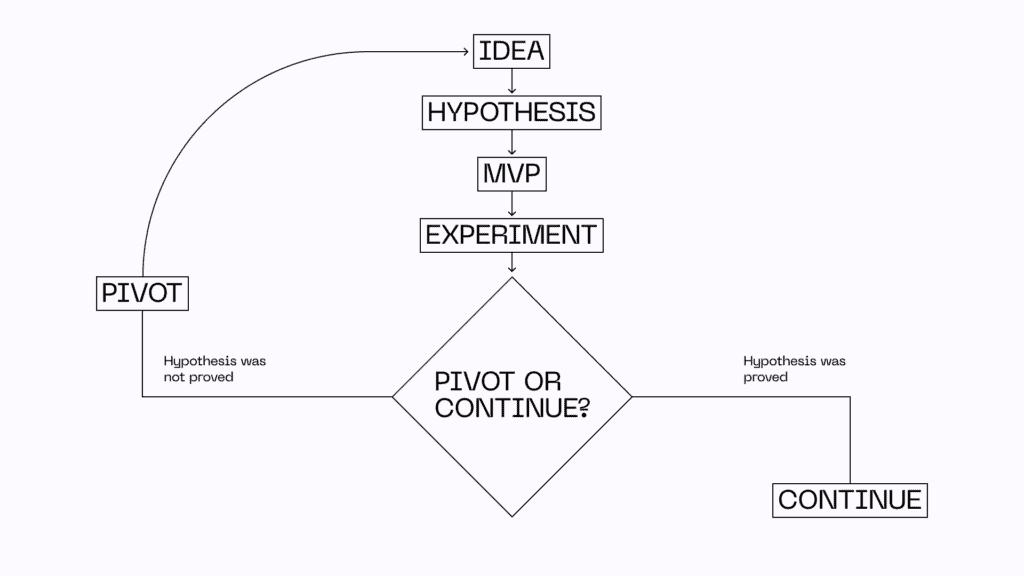
Choose the pivot type
- Customer segment pivot
This pivot typically occurs when the existing target audience is not responding as expected. It can also happen when there is a more promising market opportunity with a different group of customers. In simple terms, it means changing who you want to serve.
- Problem pivot
A problem pivot is about strategically shifting how your business addresses the main issue it solves with its product or service. It involves redefining the core problem or needs that your company’s offering deals with. Usually, this pivot happens when you realize that the original problem you were tackling might not be big enough, urgent enough, or profitable enough to keep the business going.
- Solution pivot
This pivot is about changing the central solution or approach to tackle a specific problem or need. It involves redefining how your company deals with a particular challenge or serves a specific market. You’d go for this pivot when you discover that your current solution isn’t practical, scalable, or competitive enough.
- Technology pivot
When you realize that your current technology isn’t helping your business reach its goals effectively, efficiently, or competitively, it’s time for a technology pivot. This involves redefining the technological foundation of your company’s offering.
- Business model pivot
This pivot is about reshaping how your company creates, delivers, and captures value. Usually, it happens because you need to adapt to changing market conditions, boost profitability, or take advantage of new opportunities.
Plan the pivot
- Conduct market research to understand your users’ needs, pain points, and preferences. This is crucial if you’re changing your target audience or problem.
- Redefine your value proposition to address the new focus. How will your product solve the problem or meet the needs of your revised target audience?
- Modify your product features as needed. This might involve adding, changing, or removing features.
- Assess the technical requirements for supporting the new direction. Consider infrastructure, tools, and resources.
- Create a pivot timeline that outlines the phases of the pivot, changes to the product, marketing, and more. Set milestones and deadlines.
- Plan a communication strategy explaining the pivot to your existing users, customers, and stakeholders. Highlight the benefits of the change.
Retest your MVP
Relaunching an MVP after a pivot follows the same steps as when you initially launched it. You start by clearly defining a hypothesis that can be tested, specifying your problem, identifying your target audience, and outlining your solution.
Afterward, you set up key metrics to measure your progress. Then, you plan your testing methods, gather data, and analyze the results. Finally, you make adjustments based on what you’ve learned.
The main difference between launching an MVP for the first time and relaunching it after a pivot is that you have a better sense of direction, thanks to user feedback and market insights.
Additionally, your product is often in a more advanced state because you’ve likely made improvements along the way. Your marketing efforts are also more precise, making this relaunch a different and more strategic undertaking than the initial launch. As a result, your MVP has a much greater chance of success.
Turnkey MVP development services
We will take care of your project so you can focus on your core competencies.
Contact usSuccessful MVP examples
Stripe
Many world-famous businesses have leveraged the benefits of creating an MVP. For example, Stripe started with an HTML website to verify the market demand for developer-focused payments API. Its straightforward interface offered features like card validation, secure payment processing, and support for multiple programming languages.
The simplicity, user-centric approach, and focus on solving a specific problem contributed to Stripe’s success. These factors have helped it become a leading global payment processing platform used by businesses of all sizes.
Instagram tested the waters with a social check-in app, which didn’t perform well. So, they decided to pivot and focus on one feature: image posting. The idea got traction with designers and photographers, and later, the Instagram mobile app gained wide popularity as it received filters and other features.
Slack
Slack’s journey is another excellent example of a successful pivot that ultimately led to substantial traction and success. The company’s original concept was a gaming company called Tiny Speck. They developed an internal chat tool to facilitate communication among their team members while working on their game project, Glitch.
Over time, Tiny Speck recognized that their internal chat tool had potential as a product on its own. They decided to pivot away from gaming and focus on developing and marketing this chat tool as a communication platform for businesses and teams. This is how Slack was born as we know it today.
Cost to build an MVP
A quick Google search for “How much does it cost to build an MVP?” will give you numbers ranging from $45K to over $200K. It depends on several factors, including the selected tech stack and your development team’s proficiency. That’s why asking for quotes from different development agencies will probably give you different numbers.
Our earlier blog post about custom software development costs covered this matter in detail. Now, let’s go briefly through the major cost factors.
MVP size and complexity
The more user types the software serves or the more data pieces it has to process, the more time it takes to complete. Sometimes, the software size is estimated by summarizing the number of actions the user can perform before they achieve their goal.
Additionally, most workflows can be infinitely complexified, affecting the development time and price. Moreover, enabling users to set their preferences in the system is another expense item.
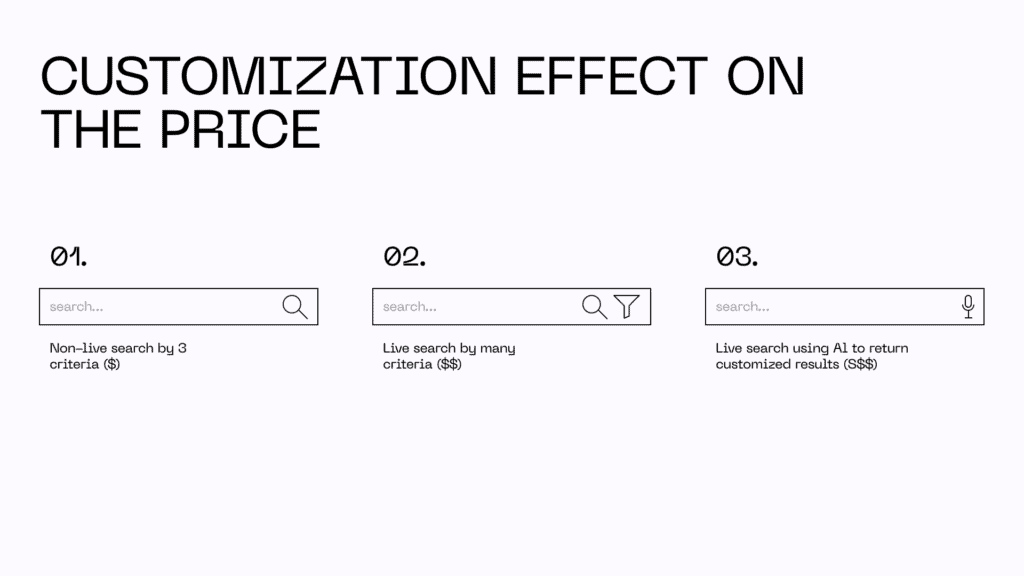
Platforms
When building an MVP for a mobile application, the number of platforms you target can add up a substantial amount to the final price tag. Thus, native iOS development usually turns out cheaper than building for Android. A cross-platform MVP is the most expensive option.
At the same time, web development is the most budget-friendly, but a desktop-only version will limit your reach. So, you might want to create an MVP web app to maximize your presence while remaining on a budget.
Integrations
The more sources you want your MVP product to connect to receive real-time data, the longer it takes. In addition, every external system has its own data inputting and updating processes that should be tailored to fit your software.
Moreover, ensuring data coherence takes much effort due to data silos when information is isolated from specific departments. Finally, data can bury each other at a certain volume, so a developer should ensure proper organization within the system.
All these challenges take time to handle and increase the cost of making an MVP.
Engagement model
An engagement model defines your relationship with the development team, areas of responsibility, timelines, payment terms, etc. MVP software development has two engagement models: Fixed-price and Time and Material. Each is better suited for specific cases and can slow down the MVP process for others, making the costs skyrocket.
Thus, the Fixed-price model requires predefined requirements, fixed timeframes, and fixed costs. It is effective when the product idea is clear, specifications are known, and there is little chance of changes. However, making changes will be costly since it involves much rework.
The Time and Material model involves billing for the actual scope of work based on the hourly rates of the team members. Contrary to the fixed-price model, it allows you to adjust needs, change direction and features, and quickly get the product to the market. On the other hand, it is hard to tell the exact cost of the product before the development starts since the scope is unclear.
How can Syndicode help with MVP building?
Syndicode is a seasoned software development company with extensive experience in MVP development. Here’s a brief overview of what our team can offer when it comes to creating an MVP:
- Preliminary research and market fit analysis. We’ll collaborate with you to figure out how to create an MVP that perfectly fits your target market. This entails understanding your audience, their needs, and the competitive landscape.
- Custom MVP development. Our skilled specialists have a track record of building various MVP products from the ground up, tailored to the unique requirements of our clients. One notable example is the Harvest Inn booking platform designed for campervan travelers.
- Technical implementation consulting and successful product launch. We provide technical consulting and brainstorming to bring your ideas to life efficiently. This includes recommending the most effective technical solutions for your MVP. For instance, we successfully launched the online education marketplace Evrlearn to the public in just 9 months, receiving positive feedback.
- Market expansion and research. Our team assists clients in broadening their customer base by delivering market research and innovative ideas. This helps you prepare your products for shifts in the market. An illustrative case is our work on the HLPRS project, where the client began receiving orders from the target market in just 10 months.
Summary: MVP development process
That is all there is to know about how to build a minimum viable product. Let’s summarize the key points.
MVP purpose: MVP software development is a simple and quick way to present your product to the target users, see if you can deliver any value, and not waste many resources.
The brief process of building an MVP: Start by talking to people who have the problem your product aims to solve. This will help you gauge if your MVP could work for them. Additionally, look for similar products and analyze their strengths and weaknesses. Use this information to equip your MVP with essential and unique features.
Next, your MVP should be likable so that users will want to try it out. So, find out what your target users think is beautiful and invest in UI/UX design. Keep it minimal, but ensure it looks nice.
Regarding the development stage, timebox your specification to things you can really build within the set timeframe. You will launch fast and get feedback to work on sooner. Then, iterate and continue improving your MVP solution until it effectively solves the problem.
Hopefully, this guide will help you build a valuable and profitable product and avoid some costly mistakes. And if you need a consultation or a responsible team to work on your MVP project, Syndicode is here for you.
Frequently asked questions
-
How long does it take to build an MVP?
The time MVP software development takes varies based on how you build an MVP and what exactly you build. Factors like the complexity of the design, the number of features you plan to include, and the availability of human resources are also important. Typically, you can expect the first release of an MVP to take anywhere from 3–6 months after the start of development.
-
Is MVP for startups only?
No, the concept of an MVP isn’t limited to startups alone. Established businesses also build MVPs when they’re looking to break into new markets, quickly test out a new feature, or gather data to inform the decision on whether to pursue an innovative idea. MVPs serve as a strategic tool for companies of all sizes to validate concepts with minimal risk.
-
How to build a good MVP?
To build a robust MVP, focus on creating a simplified yet effective version of your idea that can be quickly developed and launched. Because what’s a good MVP app? It’s an app that successfully tests your concept on a small scale, minimizing the potential negative impacts of introducing an unrefined product. It should also adapt quickly to market changes and gather essential insights efficiently. To build such an MVP, conduct basic market research to verify that there’s a demand for your idea and that it has the potential to succeed in the current market. Determine what makes your idea valuable to potential users and why they would be willing to pay for it. Next, develop a visual design that ensures your MVP is both attractive and user-friendly, enhancing its appeal to your target audience. After launching your MVP, actively seek out user feedback. This input is crucial for identifying what works, what doesn’t, and what improvements can be made in subsequent versions.
-
How to move from MVP to a full-scale product?
Transitioning from an MVP to a full-scale product involves a strategic and feedback-informed approach. Focus on the insights gathered from your MVP’s launch to refine your product and MVP process. This includes making improvements, introducing new features, or even removing elements that didn’t resonate with your audience. Pay special attention to negative feedback as it highlights areas for critical improvements. Ensure you have the necessary staff, infrastructure, and resources to support an increase in customers or orders. This step involves moving from a cautious approach to a growth mindset, ready to embrace and manage success. With a more robust product, it’s time to increase your marketing activities. Don’t forget about metric monitoring. The key metrics you tracked during the MVP phase should continue to be a priority. They offer ongoing insights into user behavior, product performance, and areas where further adjustments can enhance the user experience and lead conversion rates.
-
Do you really need an MVP?
Not every new product requires going through an MVP development process. In markets where the competition already offers a comprehensive set of features, launching a basic version may not meet customer expectations. However, if your product introduces an innovative idea that addresses previously unmet needs or significantly improves upon existing solutions in a way that makes current features obsolete, then starting with an MVP can be a strategic move.
-
What makes a successful MVP?
A successful Minimum Viable Product is a streamlined and user-centric solution that serves a specific purpose, such as solving a problem or fulfilling a need. Its primary goal is to validate market demand and use measurable metrics to assess its success. Moreover, an effective MVP should be in harmony with the long-term objectives of the business and mindful of its competitive position. It also needs to capitalize on optimal timing and actively engage users. Essentially, it’s a continuous learning process.
